|
Loch mo Naire (or ma
Naire) is about 5 miles south of the top of Scotland, and has a
long-standing tradition associated with it. Being romantically, if not
spiritually, attached to Strathnaver, we – my wife, daughter and myself -
decided to visit it at a time that is said to be magical.
Loch mo-Naire is at the northern end of Strathnaver, about 5 miles south
of Bettyhill where the River Naver enters the Atlantic Ocean, 31 or so
miles west of Thurso and 15 miles east of Tongue.
Celtic tradition has it that a local priestess/witch/medicine woman was
the possessor of bright crystal stones which when placed in water had the
power of rendering the liquid an infallible cure for all "the ills to
which flesh is heir." News of these magical stones soon spread far and
wide, and reached a member of the neighbouring clan Gordon, who decided to
steal them for the exclusive use of himself and his family. So he
pretended to be ill and went to see the woman. However, when he got there,
she saw through his ruse and ran away. Escape was impossible, as she was
getting on a bit. Rather than give up her stones, she threw them into the
first lake to which she came - subsequently named Loch mo Naire, declaring
that its waters should heal all who dipped in them or drank of them,
(except anyone belonging to the Gordons). As she threw the stones, it is
said that she shouted “Ma naire”, Celtic for “shame” and this is said by
some to be the derivation of the loch’s name. However, others will tell
you that this tradition is very much more recent than the superstition
connected with the lake and are sure that Loch mo Naire does not really
mean "the loch of shame," but "the serpent's loch," - the word for
serpent, “nathair”, being pronounced exactly in the same way as “naire”
meaning shame. Others still will tell you that “naire” is derived from the
word for the moon.
For whatever reason the loch gets its name, a legend and tradition were
born and until the mid 1800s, the healing Loch mo Naire was a site of
pilgrimage for the ill. The actual powers of the loch are said to be the
strongest on the 1st Monday of August, between 12.00 am 1.00am – for some
reason, they were said to be even stronger when this fell on 4th August.
Gathering at the shore at midnight, the sick would drink some of the
water, strip, and walk backwards into the loch. After immersing themselves
three times, they would throw offerings of silver coins into the depths
(examples of these offerings can be found in the Strathnaver Museum in
Clachan near Bettyhill - 01641 521418).
So, that’s the legend and the tradition. Having been fascinated by the
history, legend and folklore of Strathnaver for a long time, we decided
that the time was ripe to add another piece to the collection and to go
and see how many still carry the ritual out. In 2003, the first Monday of
August falls on the 4th – what better time to visit the loch? And to do it
right, it would have to be midnight, wouldn’t it. Of course, to get it
absolutely right, we’d need to be careful about BST and GMT, since spirits
care about such things, don’t they!
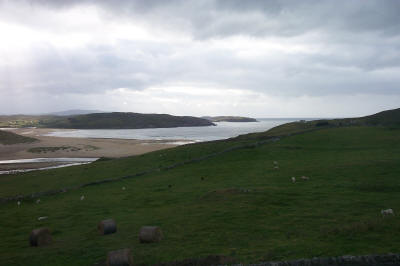 The
nearest hotel is in Bettyhill, so staying at the Bettyhill Hotel was an
obvious choice. This hotel has, shall we say, seen better days, although
under new management of only a couple of years it’s building itself back
up to its former glory. What it lacks in paintwork, it makes up for in
charm, welcome and first-rate food. And the views of Torrisdale Bay, the
early monastic site of Eilean Neave (Coomb Island) and out into the
Atlantic from the restaurant windows are absolutely breathtaking. The
building went up in 1819 as a coaching inn, so it would have been there
when the charabanc loads of ill and infirm rolled up to the loch. Maybe
some of them stayed in the room we had! The
nearest hotel is in Bettyhill, so staying at the Bettyhill Hotel was an
obvious choice. This hotel has, shall we say, seen better days, although
under new management of only a couple of years it’s building itself back
up to its former glory. What it lacks in paintwork, it makes up for in
charm, welcome and first-rate food. And the views of Torrisdale Bay, the
early monastic site of Eilean Neave (Coomb Island) and out into the
Atlantic from the restaurant windows are absolutely breathtaking. The
building went up in 1819 as a coaching inn, so it would have been there
when the charabanc loads of ill and infirm rolled up to the loch. Maybe
some of them stayed in the room we had!
If you want to do as we did and visit mo Naire at midnight, do check it
out in daylight first. The path is fairly easy, but the last bit to the
loch is across a fern and thistle-strewn field, and finding your way
across in the dark – even with a torch – isn’t so easy. To find the loch,
drive west from Bettyhill, until you reach a left turn immediately before
the bridge over the Naver. This road is signposted Skelpick, and
Achanlochy clearance village, an iron age broch, neolithic chambered tombs
and a mediaeval iron works are also down this road and worth a look if you
have time. Drive down here a couple of miles, and the tarmac suddenly
stops at a turning point. You can drive a further half mile or so if your
springs can take it. Park up somewhere that won’t stop the farmer doing
his work. It’s a busy farm – work was still going on at 11:30 pm when we
went. (We parked at map reference NC72445529.)
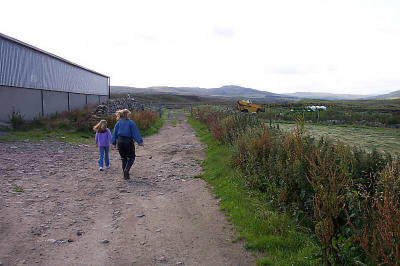
Continue down the track on
foot and you’ll reach a high metal gate through which you should pass,
following the obvious track, and a right fork when you see it. The
rock-strewn track goes on to Dunviden, where you’d find a Neolithic tomb,
an iron age broch and another clearance village, but we don’t need to go
that far. Mo Naire is about three quarters of a mile from the gate. There
is evidence that the track could get very muddy if it’s rained recently,
but in the day and night that we visited it was easy walking. At night,
the walk is glorious – allow your eyes to become dark-adapted and you’ll
be able to see enough to walk with care and you’ll benefit from the
ambiance of the area. You’ll see the loch as you reach the top of one of
the later rises, on the right of the track. Look out for a high deer fence
which runs parallel with the track and you’ll see a gate in it, through
which you pass. If you find yourself walking parallel with the loch,
you’ve gone too far. In daylight the gate is easy to find, in the dark it
isn’t!
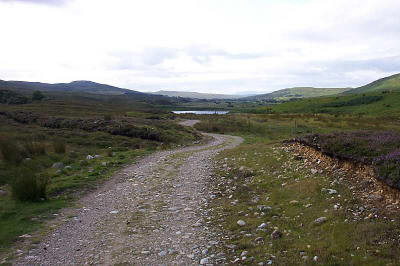
Once through the gate, you
can see the loch all the time, and you need to aim for a point about half
way across the end of it nearest you. Here, you’ll find a little sandy
beach (NC72595385). When we made our visit, the water lilies were evident
and the last remnants of the light made it easy to believe that the loch
does, indeed, have magical powers! It’s a pity that the magic day is in
August; were it June, it wouldn’t really get dark! If you do this at
midnight, and are of a nervous disposition, the sheep can be troublesome.
They rustle the ferns a lot, and their eyes are a bit eerie in the
torchlight! Hmm – eerie sheep. Be afraid, be very afraid! When your
nine-year-old daughter tells you she’s scared of the sheep, you just have
to tell her that it’s OK, they’re only sheep, and there’s nothing to worry
about - even if your knees are shaking wildly!
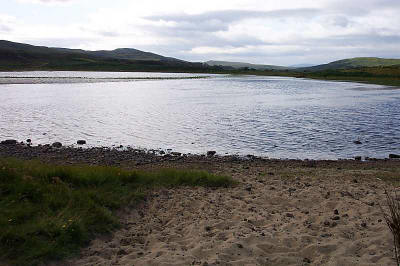
So, why has the legend
built up the way it has, why did it last past the middle of the 18th
century, and why were we here in the middle of the night? Well, visit the
loch at any time and you’ll know what spirituality is – whatever you
believe. The loch is silent, dark and moody. It is surrounded by low hills
and it’s as though the loch is looking at you and waiting for you to come
closer. It has a certain something about it, without doubt. Visit it at
midnight and these things take on a whole additional level of
spirituality. For a start, you’ve walked in near darkness for 20 minutes
or so, you’ve looked at the hills around you, and you’ve heard the
rustling and grunting of animals – your senses are tuned to a very high
level. Get to the loch and my goodness everything is there for you.
Whatever you believe in, you believe in it a lot more once you are there!
By midnight in August, the last vestiges of light have gone from the sky,
so the water is black. Up here, of course, there is no light pollution
from streetlights to disturb the tranquillity and the wonder of the place.
We just stood and looked at it for a long time – even my daughter who can
be a tad cynical about these things. It was very easy to see why
coachloads of people came here to have their ills cured. As we stood
there, there was no sound, there was no distance (the hills were in the
way), and no views. There was just us and the loch. It looked at us and we
looked at it. It said to us, “Come closer and speak to me”. So we did. We
looked out across the black water and could see it go on for ever – the
opposite shore was invisible and the transition from water to land wasn’t
there – we were looking back in time to the Clearances, to the Iron Age,
to the Neolithic times, to prehistoric times – all the history witnessed
by the loch itself. Midnight came and went and we looked at the loch, and
the loch looked at us.
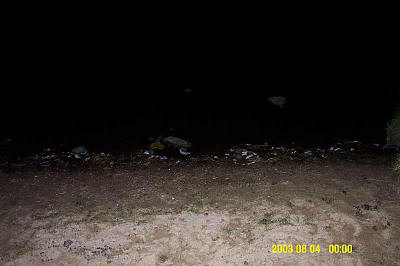
Now, going back to the BST
and GMT issue, and whether we should walk naked, backwards into the loch.
We decided that it would be inappropriate. Well, OK, we chickened out and
there were other good reasons too, of which more later. We did, however,
rinse our hands in the water at 11:55 and 00:05 (to ensure that we got the
benefit whether the magic adhered to GMT or BST). The big question is, of
course, whether anything magical happened at midnight. Well, I can tell
you that it DID! On the stroke of midnight, the wind dropped to nothing –
a flat calm. “Wonderful”, we thought, until the scourge of the highlands
also noticed that the wind had dropped and the midges, bless them, arose
to begin their midnight feast on us. We were very pleased that we hadn’t
stripped naked, and admired those of our ancestors who had!
We dragged ourselves away from the loch with a feeling that this was a
magical place without doubt. We also walked away from the ferns and back
to the hard track and relief from the midges.
Was it worth doing? Yes, of course it was. It was an adventure and it
relived a piece of this area’s history. As to the question of how many
people we met at the loch side, hoping that their ills would be cured –
there were none. Not a soul. So, is the legend and the tradition dead? It
can’t be, can it? We were there!
Useful
resources:
Ordnance Survey Landranger Series sheet 10,
Strathnaver.
What to see around Bettyhill, K J O'Reilly (available by post from
Strathnaver Museum)
Visit Ian's web
site here! |
